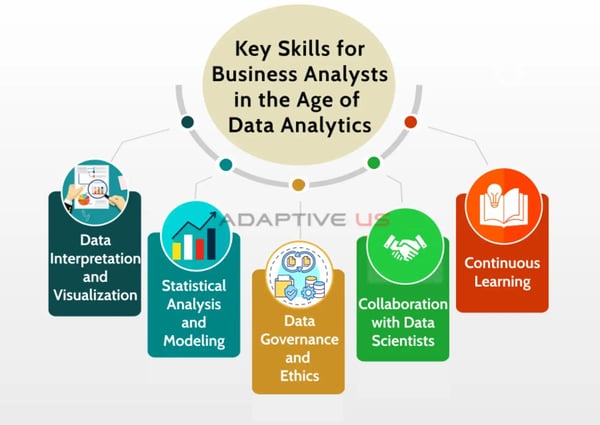Harnessing the Power of Data Analytics in Business Analysis
In the fast-paced world of business, the ability to turn raw data into actionable insights that can drive the businesses of the future has become a game-changer. As businesses increasingly rely on data-driven decision-making, it’s the right time for Business Analysts (BAs) to be at the forefront of driving growth. They can do so by harnessing the power of data analytics to drive innovation, efficiency, and strategic growth.
The Evolution of Business Analysis in the Data Age
Business Analysis has come a long way from its traditional requirements elicitation, business process mapping, and modeling roots. Today, it encompasses a broader, more dynamic role that demands a high-level overview of business processes and proficiency in interpreting and leveraging data. With the rise of big data, predictive and advanced analytics, and artificial intelligence, a Business Analyst now has the opportunity to provide organizations with a competitive edge by uncovering patterns, trends, and valuable insights/predictions hidden within vast datasets.
The Strategic Role of Data Analytics in Business Analysis

Data analytics is not just about crunching numbers; it's about transforming information into strategic advantages. BAs armed with data analytics skills can facilitate evidence-based decision-making, optimize processes, and identify opportunities for innovation. Let's explore key areas where the synergy between data analytics and business analysis creates transformative outcomes:
- Predictive Analysis for Informed Decision-Making: Predictive analytics enables BAs to forecast future trends and outcomes based on historical data. By leveraging this capability, BAs can assist organizations in making proactive, informed decisions, whether anticipating customer preferences, predicting future product demands, identifying market shifts, or optimizing resource allocation.
- Optimizing Business Processes with Prescriptive Analytics: Prescriptive analytics goes beyond predicting outcomes; it recommends actions to maximize desired results and minimize failures. BAs skilled in prescriptive analytics can streamline and enhance business processes by providing actionable insights. This improves operational efficiency and allows organizations to adapt swiftly to changing market dynamics.
- Enhancing Customer Experience through Descriptive Analytics: Descriptive analytics helps organizations understand what has happened in the past. BAs can use this information to identify patterns and trends, offering valuable insights into customer behavior and preferences. Armed with this knowledge, businesses can tailor their products and services to meet customer expectations more effectively.
- Mitigating Risks with Diagnostic Analytics: Diagnostic analytics focuses on what went wrong and what went right. It also focuses on identifying the root causes of issues and challenges. BAs skilled in diagnostic analytics can help organizations discover weaknesses in their processes, enabling them to address and mitigate risks proactively. This safeguards the business and fosters a culture of continuous improvement.
Key Skills for Business Analysts in the Age of Data Analytics

To fully harness the power of data analytics, BAs must cultivate a diverse skill set beyond traditional business analysis skills. Here are key skills essential for BAs navigating the data-centric landscape:
- Data Interpretation and Visualization: BAs must be adept at interpreting complex datasets and presenting findings in a visually compelling manner. Visualization tools like Tableau or Power BI can be valuable assets in conveying insights to stakeholders.
- Statistical Analysis and Modeling: A solid understanding of statistical concepts and modeling techniques helps a BA churn large amounts of data and equips BAs to derive meaningful conclusions from data. Regression analysis, clustering, and machine learning are examples of valuable tools in a BA's toolkit.
- Data Governance and Ethics: BAs must be conscious of data governance principles and ethical considerations surrounding data use. This includes ensuring data accuracy, privacy, and compliance with regulatory standards.
- Collaboration with Data Scientists: Collaborating with data scientists allows BAs to leverage specialized machine learning and advanced analytics expertise. Working together, BAs and data scientists can uncover deeper insights and deliver more comprehensive solutions.
- Continuous Learning: Given the rapid evolution of data analytics technologies, BAs must commit to continuous learning. Staying abreast of industry trends, attending training programs, and obtaining relevant certifications are vital for professional growth.
Data analytics bootcamp covering data manipulation, visualization tools, and techniques can be a great value add for business analysts.
Challenges and Solutions in Integrating Data Analytics into Business Analysis
While the benefits of integrating data analytics into business analysis are substantial, there are challenges to overcome. Common hurdles include data quality issues, resistance to change, and the need for substantial technological investments. Here's how BAs can navigate these challenges:
- Data Quality Assurance: BAs should prioritize data quality assurance by establishing robust data governance practices. This includes validating data sources, ensuring data accuracy, and implementing processes for cleaning and transforming data.
- Change Management: Resistance to change is a common challenge when introducing new technologies or methodologies. BAs can overcome this by fostering a culture of data-driven decision-making, emphasizing the positive impact on outcomes, using their interpersonal skills to influence, and providing comprehensive training to team members.
- Cost-Effective Implementation: Implementing data analytics solutions can be resource-intensive. BAs should collaborate with stakeholders to identify cost-effective solutions and demonstrate the long-term value of the investment through tangible benefits such as increased efficiency, improved decision-making, and competitive advantages.
- Effective Communication: Communicating complex data insights to stakeholders who may not have a technical background can be challenging. BAs should hone their communication skills and ability to break it down to simple content, translating technical jargon into actionable insights that resonate with diverse audiences.
Real-world Success Stories: How Businesses Thrive with Data-Driven Business Analysis
To bring the organization into concurrence, explore real-world success stories / use cases and showcase the practical impact of data analytics in business analysis. Highlight organizations that have experienced tangible benefits, improved market share, and superior customer experience, such as improved operational efficiency, enhanced customer satisfaction, and increased profitability, thanks to the strategic integration of data analytics into their business analysis processes.
Conclusion: The Future of Business Analysis is Data-Driven
As the business landscape continues to evolve, integrating data analytics into business analysis will become increasingly essential. BAs who embrace this evolution, equip themselves with relevant skills, and navigate challenges effectively will drive success within their organizations and position themselves as indispensable contributors to the future of business analysis. The journey to harnessing the power of data analytics is an exciting one, filled with opportunities for growth, innovation, and transformative impact.

You May Also Like
These Related Stories

A Must-Know List of Data Analytics Tools for A Data Analyst

10 Must-Read Books to Excel as a Data Analyst



Comments (1)